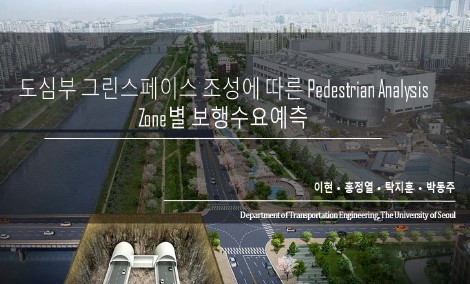3. 도심부 그린스페이스 조성에 따른 Pedestrian Analysis Zone별 보행수요예측 / 이현, 홍정열, 탁지훈, …
구두 Session 1, 교통계획및정책1, 30(금) 09:30-11:00, 볼룸4, pp.73-78
도심부 그린스페이스 조성에 따른 Pedestrian Analysis Zone별 보행수요예측 / 이현(서울시립대학교), 홍정열(사울시립대학교), 탁지훈(사울시립대학교), 박동주(사울시립대학교)
With the continuous development of science and technology, people's trip modes are becoming more diversified. Nevertheless, the number of people using vehicles keep on soaring, causing traffic congestion to increase further. For this reason, many urban cities are experiencing traffic problems leading to increased pollution and social costs. As a remedy, policymakers have made several recommendations such as walking or using public transport modes instead of private cars, particularly during peak hours. Recently, researchers at home and abroad have tried to solve the problems mentioned above through pedestrian-oriented road planning. They achieved their goal by redesigning urban spaces, replacing preexisting roadways with underground tunnels, and creating projects such as green spaces, parks, and sports facilities on the spaces above the tunnels that were previously occupied by roadways. Similar to the case of Seoul, the traffic congestion problem has increased considerably. To alleviate the traffic congestion situation, city planners sought to improve the pedestrian environment by reducing the width of roadway lanes and establishing a green space on Seoul's western arterial highway. By using this green space area as a case study, this research aims at estimating the number of pedestrians that would use the green space and developing a walking encouragement index. We employed data such as pedestrian flow, building area, and land use from the western arterial highway in Seoul, together with a regression model to forecast the number of pedestrians that use the green space located in the study area. This newly derived information is then used in a simulation framework to estimate the number of pedestrians that will pass by the green space. From the regression model results, we identified that factors such as sidewalks, commercial areas and bus interchange points have a positive impact on pedestrian volume, whereas walking distance has a negative effect. The results of this study confirms that good pedestrian environments can encourage walking and can also help policymakers to understand the effect of different land use factors on pedestrian volume.
좌장 : 김채만, 김종형
















